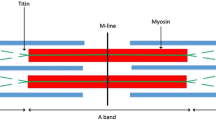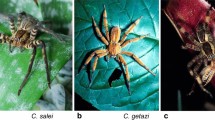Abstract
A crawling paradigm was performed by healthy adults to examine inter-limb coupling patterns and to understand how central pattern generators (CPGs) for the upper and lower limbs are coordinated. Ten participants performed hands-and-feet crawling on two separate treadmills, one for the upper limbs and another one for the lower limbs, the speed of each of them being changed independently. A 1:1 frequency relationship was often maintained even when the treadmill speed was not matched between the upper and lower limbs. However, relative stance durations in the upper limbs were only affected by changes of the upper limb treadmill speed, suggesting that although absolute times are adjusted, the relative proportions of stances and swing do not adapt to changes in lower limb treadmill speeds. With large differences between treadmill speeds, changes in upper and lower limb coupling ratio tended to occur when the upper limbs stepped at slower speeds than the lower limbs, but more rarely the other way around. These findings are in sharp contrast with those in the cat, where forelimbs always follow the rhythm of the faster moving hindlimbs. However, the fact that an integer frequency ratio is often maintained between the upper and lower limbs supports evidence of coupled CPG control. We speculate that the preference for the upper limb to decrease step frequency at lower speeds in humans may be due to weaker ascending propriospinal connections and/or a larger influence of cortical control on the upper limbs which allows for an overriding of spinal CPG control.





Similar content being viewed by others
References
Akay T, McVea DA, Tachibana A, Pearson KG (2006) Coordination of fore and hind leg stepping in cats on a transversely-split treadmill. Exp Brain Res 175(2):211–222
Ballion B, Morin D, Viala D (2001) Forelimb locomotor generators and quadrupedal locomotion in the neonatal rat. Eur J Neurosci 14(10):1727–1738
de Sèze M, Falgairolle M, Viel S, Assaiante C, Cazalets JR (2008) Sequential activation of axial muscles during different forms of rhythmic behavior in man. Exp Brain Res 185:237–247
Dietz V, Michel J (2009) Human bipeds use quadrupedal coordination during locomotion. Ann NY Acad Sci 1164:97–103
Dietz V, Fouad K, Bastiaanse CM (2001) Neuronal coordination of arm and leg movements during human locomotion. Eur J Neurosci 14(11):1906–1914
Donker SF, Mulder T, Nienhuis B, Duysens J (2002) Adaptations in arm movements for added mass to wrist or ankle during walking. Exp Brain Res 146(1):26–31
Falgairolle M, de Sèze M, Juvin L, Morin D, Cazalets JR (2006) Coordinated network functioning in the spinal cord: an evolutionary perspective. J Physiol (Paris) 100:304–316
Fischer MS, Blickhan R (2006) The tri-segmented limbs of therian mammals: kinematics, dynamics, and self-stabilization—a review. J Exp Zool A Comp Exp Biol 305(11):935–952
Getchell N, Forrester L, Whitall J (2001) Individual differences and similarities in the stability, timing consistency, and natural frequency of rhythmic coordinated actions. Res Q Exerc Sport 72:13–21
Halbertsma JM (1983) The stride cycle of the cat: the modelling of locomotion by computerized analysis of automatic recordings. Acta Physiol Scand Suppl 521:1–75
Haridas C, Zehr EP (2003) Coordinated interlimb compensatory responses to electrical stimulation of cutaneous nerves in the hand and foot during walking. J Neurophysiol 90(5):2850–2861
Ivanenko YP, Cappellini G, Dominici N, Poppele RE, Lacquaniti F (2005) Coordination of locomotion with voluntary movements in humans. J Neurosci 25:7238–7253
Juvin L, Simmers J, Morin D (2005) Propriospinal circuitry underlying interlimb coordination in mammalian quadrupedal locomotion. J Neurosci 25(25):6025–6035
Juvin L, Le Gal JP, Simmers J, Morin D (2012) Cervicolumbar coordination in mammalian quadrupedal locomotion: role of spinal thoracic circuitry and limb sensory inputs. J Neurosci 32(3):953–965
MacLellan MJ, Qaderdan K, Koehestanie P, Duysens J, McFadyen BJ (2012a) Arm movements during split-belt walking reveal predominant patterns of interlimb coupling. Hum Mov Sci. doi:10.1016/j.humov.2012.08.001
MacLellan MJ, Ivanenko YP, Cappellini G, Sylos Labini F, Lacquaniti F (2012b) Features of hand-foot crawling behavior in human adults. J Neurophysiol 107(1):114–125
Nakajima K, Maier MA, Kirkwood PA, Lemon RN (2000) Striking differences in transmission of corticospinal excitation to upper limb motoneurons in two primate species. J Neurophysiol 84(2):698–709
Nathan PW, Smith M, Deacon P (1996) Vestibulospinal, reticulospinal and descending propriospinal nerve fibres in man. Brain 119:1809–1833
Orlovsky GN, Deliagina TG, Grillner S (1999) Neuronal control of locomotion. Oxford University Press, Oxford
Patrick SK, Noah JA, Yang JF (2009) Interlimb coordination in human crawling reveals similarities in development and neural control with quadrupeds. J Neurophysiol 101:603–613
Patrick SK, Noah JA, Yang JF (2012) Developmental constraints of quadrupedal coordination across crawling styles in human infants. J Neurophysiol 107(11):3050–3061
Reisman DS, Block HJ, Bastian AJ (2005) Interlimb coordination during locomotion: what can be adapted and stored? J Neurophysiol 94(4):2403–2415
Sparrow WA, Newell KM (1994) The coordination and control of human creeping with increases in speed. Behav Brain Res 63(2):151–158
Tan U (2010) Uner Tan syndrome: history, clinical evaluations, genetics, and the dynamics of human quadrupedalism. Open Neurol J 4:78–89
Thibaudier Y, Hurteau MF (2012) Sensory regulation of quadrupedal locomotion: a top-down or bottom-up control system? J Neurophysiol 108(3):709–711
Wannier T, Bastiaanse C, Colombo G, Dietz V (2001) Arm to leg coordination in humans during walking, creeping and swimming activities. Exp Brain Res 141(3):375–379
Webb D, Tuttle RH, Baksh M (1994) Pendular activity of human upper limbs during slow and normal walking. Am J Phys Anthropol 93(4):477–489
Zehr EP, Frigon A, Hoogenboom N, Collins DF (2004) Facilitation of soleus H-reflex amplitude evoked by cutaneous nerve stimulation at the wrist is not suppressed by rhythmic arm movement. Exp Brain Res 159(3):382–388
Zehr EP, Hundza SR, Vasudevan EV (2009) The quadrupedal nature of human bipedal locomotion. Exerc Sport Sci Rev 37:102–108
Zelenin PV, Deliagina TG, Orlovsky GN, Karayannidou A, Dasgupta NM, Sirota MG, Beloozerova IN (2011) Contribution of different limb controllers to modulation of motor cortex neurons during locomotion. J Neurosci 31(12):4636–4649
Acknowledgments
This work was supported by the Italian Ministry of Health, Italian Ministry of University and Research (PRIN grant), Italian Space Agency (DCMC and CRUSOE grants) and European Union FP7-ICT program (AMARSi grant #248311). The authors also thank Dr. G. Bosco for the comments on the preliminary results.
Author information
Authors and Affiliations
Corresponding author
Rights and permissions
About this article
Cite this article
MacLellan, M.J., Ivanenko, Y.P., Catavitello, G. et al. Coupling of upper and lower limb pattern generators during human crawling at different arm/leg speed combinations. Exp Brain Res 225, 217–225 (2013). https://doi.org/10.1007/s00221-012-3364-5
Received:
Accepted:
Published:
Issue Date:
DOI: https://doi.org/10.1007/s00221-012-3364-5




